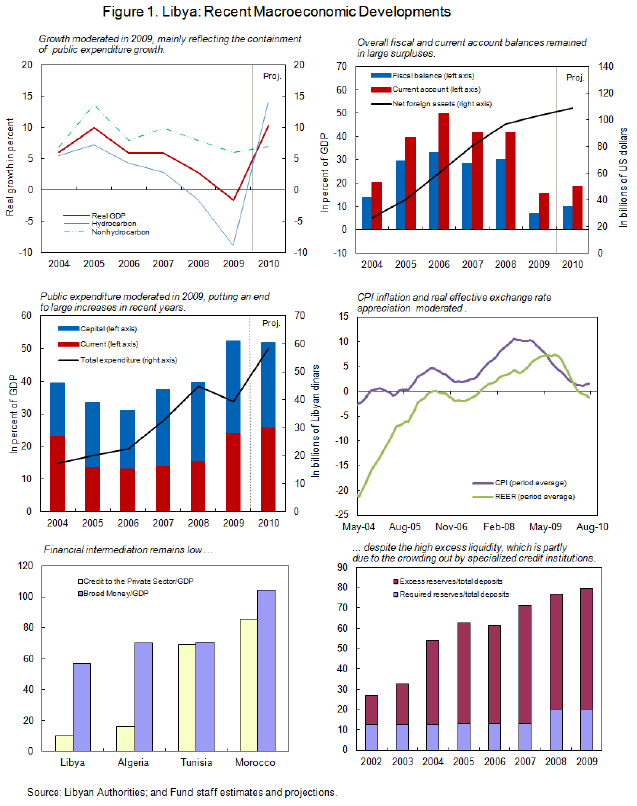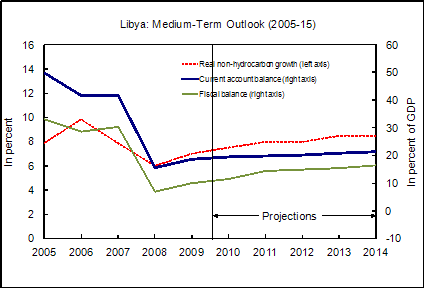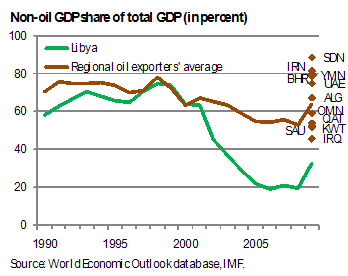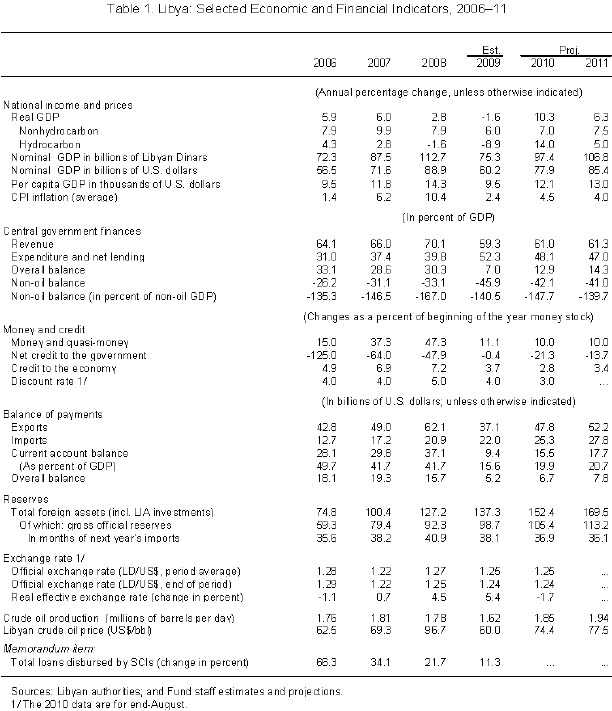The Socialist People’s Libyan Arab Jamahiriya -- 2010 Article IV Consultation, Preliminary Conclusions of the Mission
November 4, 2010
Describes the preliminary findings of IMF staff at the conclusion of certain missions (official staff visits, in most cases to member countries). Missions are undertaken as part of regular (usually annual) consultations under Article IV of the IMF's Articles of Agreement, in the context of a request to use IMF resources (borrow from the IMF), as part of discussions of staff monitored programs, and as part of other staff reviews of economic developments.
An IMF mission visited Libya during October 17–28, 2010 to conduct discussions for the 2010 Article IV consultation. The mission would like to thank the authorities for their excellent cooperation and hospitality.
I. Background and Recent Developments
1. The macroeconomic environment is strong, underpinned by large fiscal and external positions and continued efforts to modernize and diversify the economy. The mission commends the authorities on efforts to enhance the role of the private sector in the economy, including by passing a number of critical laws that build on the initiatives launched over the past few years to modernize the economy. These achievements have contributed to the favorable sovereign ratings assigned to the country for the second year by international rating agencies. The authorities are aware of the many challenges that remain to diversify the economy and to help create viable employment opportunities for the growing labor force.
2. The impact of the global financial crisis on Libya has been thus far limited to the decline in oil revenue. This was due to the lack of exposure of domestic banks to the global financial system, limited trade ties outside of the oil sector, and large foreign reserves held in safe assets. The Libyan Investment Authority (LIA) has come through the global financial crisis relatively unscathed. The oil sector has continued to benefit from commitments of foreign direct investment.
3. Nonhydrocarbon growth has been solid on the backdrop of high domestic demand. Notwithstanding a noticeable fiscal contraction in 2009, nonhydrocarbon real GDP grew by an estimated 6 percent in 2009, mainly driven by investments in construction and in services. Meanwhile, hydrocarbon output declined significantly due to compliance with OPEC quota, resulting in a contraction of overall real GDP by an estimated 1.6 percent. Overall growth is projected to increase markedly to around 10 percent in 2010 due to a sharp increase in oil production. At the same time, nonhydrocarbon growth will also strengthen (to about 7 percent) as a result of large public expenditures. Inflation is expected to pick up to about 4.5 percent in 2010 (from 2.5 percent in 2009) as higher oil revenue increases domestic liquidity and international commodity prices increase.
4. After a sharp decline in 2009, the fiscal surplus is projected to increase in 2010 mainly owing to the projected recovery in oil revenue. The fiscal surplus narrowed sharply to about 7.0 percent of GDP in 2009 as a result of a sharp decline in oil revenue (44 percent) that has more than offset the reduction in public outlays (12 percent). The latter reflects the net effect of a decline in capital spending (23 percent) and a 5 percent increase in current outlays. The increase in current spending reflects higher subsidies due to explicitly accounting for energy subsidies and transfers to the Economic and Social Development Fund (ESDF). At the same time, current expenditure is envisaged to increase by 19 percent, compared to 2009, largely due to full explicit accounting of energy subsidies, and a 15 percent increase in the wage bill. The ongoing prioritization of investment projects would allow capital expenditure to increase by about 18 percent, compared to the budgeted increase of almost 60 percent.
5. Broad money is projected to grow by about 10 percent, although the assessment of monetary development has been complicated by numerous revisions. Commercial bank lending to the private sector and nonfinancial public enterprises has been constrained by lack of adequate borrower documentation, strengthening of regulation, and high liquidity at public enterprises. The latter’s demand for bank services has been largely limited to letter of credits (LCs) and guarantees (LGs).Excess liquidity has remained high in the banking system, and financial intermediation is weak compared to neighboring countries.1 The banking system is sufficiently capitalized with a regulatory capital ratio of 16.3 percent. Non-performing loans have slightly increased to 15.5 percent as of end-June while loan provisions at over 100 percent have improved over the last years. LCs and LGs have flourished with domestic currency LCs increasing by almost 200 percent so far in 2010 and overall off-balance sheet LCs and LGs totaling 84 percent of overall on-balance sheet bank assets.
6. The external current account surplus is projected to increase to about 20 percent of GDP in 2010, after a having narrowed sharply in 2009 (16 percent of GDP). Export earnings are projected to rebound in line with the recovery in crude oil output and prices. Imports, while also picking up due to strong domestic demand, have been steadier and remain about a third lower than exports. Net foreign assets of the Central Bank of Libya (CBL) and the LIA have consequently continued to increase, and are projected to reach $150 billion by end-2010 (the equivalent of almost 160 percent of GDP).
|
II. Medium Term Outlook and Risks 7. Libya’s economic growth and financial position are expected to strengthen over the medium term as a result of higher oil receipts and investment in the oil sector, the upgrading of infrastructure, the implementation of reforms, and continued interest of foreign investors. Oil production is projected to increase to about 2.5 million barrels per day by 2015 on account of large investments and the utilization of advanced technologies by foreign partners. The non-hydrocarbon sector is also expected to remain buoyant, boosting growth to a projected 8 percent by 2015. Taking into account the authorities’ intention to continue to prioritize spending, the growth of public expenditure is expected to remain moderate at about 7 percent a year in nominal terms. This would also allow for nominal import growth of about 10 percent a year while maintaining current account surpluses of about 20 percent of GDP. Such large surpluses imply correspondingly large increases in foreign assets, with the LIA and CBL’s portfolio projected to reach over $250 billion by 2015.
8. This medium-term outlook is subject to possible downside risks relating to a further worsening in global economic conditions, which could trigger a large decline in oil prices, or a wavering of the efforts to contain public expenditure and to implement planned reforms. If these risks materialize, economic growth, as well as the fiscal and external balances, would be well below the above projections. III. Policy Discussions A. Fiscal Policy 9. The 2010 budget provides for a large increase in expenditure, after a sizeable contraction in 2009, resuming the expansionary fiscal stance of recent years.2 The mission welcomes the progress made to enhance transparency in recording subsidies. It also supports the much needed investment in infrastructure to facilitate private sector development. At the same time, the mission recommends (i) linking the increase in public wages to performance, in the context of a comprehensive civil service reform; (ii) emphasizing high quality public investments guided by the World Bank public expenditure review; (iii) being ready to reverse discretionary outlays and making other adjustments to the fiscal stance over the medium-term to increase flexibility in the budget; and (iv) phasing out subsidies along with developing mechanisms to mitigate adverse impact on low income groups. 10. The preparation of the investment budget in a medium-term framework starting in 2010 is a move in the right direction and should be enhanced going forward. A total public investment of about 84 billions of Libyan dinars would be implemented during 2010−12. The mission recommends expanding the medium-term framework to include current spending. This will help insulate implementation of fiscal policy, especially with regard to priority investment projects, from oil price volatility. 11. The new income tax law passed in January 2010 creates the potential for simplifying tax compliance, reducing discretionary administration and motivating greater compliance. The new law harmonizes the tax rates and reduces them to a flat rate of 10 percent and 20 percent on individuals and corporates, respectively. This law replaces a fairly ad hoc approach, which previously led to tax rates of 15−40 percent. The law also shifts tax compliance to self-assessment with risk-based audits. The mission encourages the authorities to further strengthen tax administration to ensure effective implementation of the new law. 12. Public financial management needs to be improved. Some progress has been made as illustrated by the effective unification of the current and investment budgets, along with some improvements in the budget classification, and the streamlining of government entities bank accounts. At the same time, the current framework governing the state budget appears to be cumbersome, which complicates fiscal management. Furthermore, the budget continues to allocate non-negligible amounts to SCIs. The mission encourages the authorities to proceed with their plans to (i) improve public financial management, including, among other things, finalizing plans to establish a treasury single account (TSA) at the central bank; (ii) streamline and modernize budget procedures to facilitate public expenditure management (iii) reduce the allocations to SCIs, which would facilitate expenditure monitoring and control; and (iv) further enhance consistency of budget classification to facilitate budget analysis. 13. The LIA Law passed in early 2010 enhances its regulatory and operational framework and reflects many of staff’s recommendations. In particular, the law clearly indicates that the LIA’s investment should be abroad and made on a commercial basis, and should mainly concentrate on low risk assets in order to protect future generations’ share in the national wealth. The law also empowers the LIA to retain all its profits, with no more transfer to the budget. The LIA has come through the global financial crisis relatively unscathed as it has focused its financial investments on low-risk fixed-income assets. B. Monetary Policy and Financial Sector Reforms 14. The introduction in 2008 of CBL’s CDs is an important step toward enhancing the monetary policy framework, but important impediments remain. To consolidate progress, the CBL introduced in early 2010 a new 28-days CD maturity, in addition to the existing 91-days maturity, established an overnight facility, and banks were allowed to set their interest rates as they see fit. The mission encourages the authorities to proceed with their plan to (i) introduce an auction mechanism for the CDs and increase the CD maturity range; (ii) enhance the settlement system to help develop a secondary market; (iii) develop a liquidity forecasting system to enhance the effectiveness of monetary policy, and (iv) strengthen coordination with fiscal policy to limit the injection of liquidity, including by the SCIs. 15. Banking supervision according to the Basel core principles has made significant headway, and a comprehensive strategic plan for 2009–2011, serves as guidance especially for capacity building. The mission encourages the CBL to further enhance coordination between the off-site and on-site supervision units as well as capacity building through additional staffing and training. The mission also stresses the importance of scaling back the operations of the SCIs, and developing a plan to reform them. 16. Managing effectively the large and rapidly growing portfolio of foreign assets will be a key challenge. In this regard, it will be important to finalize and implement the reserve management policy and investment guidelines, establish systems for measuring and managing risks and returns, develop operational benchmarks, and enhance the reporting framework. The staff stands ready to follow up on the technical assistance provided in June 2010. 17. The presence of different government funds calls for an overall sovereign asset management strategy. The roles, risk management, and strategic asset allocation of each institution should be complementary and take into account the overall sovereign balance sheet – including macroeconomic vulnerabilities and petroleum wealth still under ground. The establishment of the joint CBL-LIA domestic investment fund may give rise to unnecessary reputational risk. 18. Progress has been made in modernizing the banking system. While it takes time, efforts should be stepped up to improve the credit culture in Libya through specialized training, targeted awareness campaign, and learning from cross-country experiences in order to spur financial intermediation. The restructuring of the CBL and its move to functional-based operations should help enhance inter-departmental coordination and efficiency, and strengthen the conduct of monetary policy. The mission welcomes the recent agreement between the CBL and the IMF to strengthen the AML/CFT unit at the CBL. 19. Efforts to deepen the financial market are commendable. There are no more fully government-owned banks, and foreign partners are involved in six out of the 16 operating banks. The increase of foreign bank participation with the granting of one license at the beginning of August will enhance competition, help develop a loan syndication market for the pipeline of foreign investments as well as bring further best practices to the Libyan banking sector. Furthermore, the number of listed companies on the Libyan stock exchange increased to 10 and is expected to reach 14 by end-year. C. Exchange Rate 20. The real effective exchange rate of the Libyan dinar has appreciated by about 5 percent in 2009 and depreciated by about 1.7 percent in the year to August 2010. Empirical estimates indicate that the dinar was moderately overvalued at end-2009. This is consistent with the change in fundamentals in line with the decline in oil prices. The results also show that the moderate misalignment will steadily decline over the medium-term with the strengthening of macroeconomic fundamentals. However, the current assessment should be interpreted cautiously as the distortions in the economy make it difficult to accurately assess the proper exchange rate level. On this basis, the mission does not recommend a change in the current dinar/SDR level. Also, the mission does not recommend a change in the exchange regime until the CBL builds sufficient capacity to conduct a more effective monetary policy. Currently, the dinar’s peg to the SDR provides a monetary anchor while allowing some flexibility in its exchange rate vis-à-vis individual major currencies. D. Other Structural Reforms 21. The overarching challenge is to promote growth of the non-hydrocarbon sector and spur diversification of the economy. With the hydrocarbon representing over 90 percent of government revenue and 95 percent of exports, Libya is one of the least diversified oil-producing countries in the Middle East. The passing in 2010 of a number of far reaching laws will help improve the business environment, which is crucial to fostering private sector development and to attracting foreign direct investment.3 The success of these laws calls for sustained efforts to build a consensus on their validity and to boost their credibility. The mission encourages the authorities to (i) establish permanent bodies with adequate resources to monitor, assess, and oversee the implementation of the law reforms; (ii) set up an open consultation process with the legal and business communities that provide the needed knowledge on actual business practices and requirements; and (iii) improve inter-agency coordination.
22. Progress has been made in customs reform. The mission welcomes the ongoing tariff harmonization, streamlining of clearance procedures, and modernizing of customs administration, which have led to efficiency gains and improved revenue collection. The authorities are encouraged to continue efforts aimed at simplifying tariffs, speeding trade facilitation, and moving to risk-based auditing and expanding the electronic information systems. This will facilitate the ongoing negotiations for WTO membership and Association Agreement with the EU. 23. Progress has been made in reducing civil service employment, but a comprehensive civil service reform is still lacking. Out of the 340,000 public employees that were previously transferred to a central labor office for retrenchment, about a quarter have reportedly found other sources of income and are no longer receiving transfers from the state budget. The mission recommends that the retrenchment program be accelerated. The mission also recommends that a comprehensive civil service reform be implemented, in consultation with the World Bank, to facilitate the design of more effective wage and employment policies. 24. While some progress has been achieved in recent years, data weaknesses continue to hamper effective policymaking. Significant data weaknesses in terms of coverage, consistency, periodicity, and timeliness remain. The timeliness of monetary data has improved significantly, but these data have been undergoing revisions for the last two years, which complicate the assessment of monetary stance. Progress in addressing serious deficiencies in real sector and government finance statistics has been limited, and national account statistics suffer from methodological problems and do not fully capture the activity of the non hydrocarbon sector. The mission urges the authorities to double their efforts to improve economic and financial statistics, including using the GDDS framework.
1 Commercial banks’ deposits with the Central Bank of Libya (CBL) amount to almost 65 percent at the end of September 2010. 2 Staff’s fiscal sustainability analysis suggests a sustainable benchmark for total spending of about LD 48 billion at current oil prices, compared to about LD 35 billion at 2009 prices. Budgeted expenditure for 2010 is about LD 62 billion. 3 Amongst the most critical of these laws are the Commercial Law, Customs Law, Income Tax Law, Stock Market Law, Labor Law, Libyan Investment Authority Law, Communications Law, and Land Registry Law. |
IMF EXTERNAL RELATIONS DEPARTMENT
| Public Affairs | Media Relations | |||
|---|---|---|---|---|
| E-mail: | publicaffairs@imf.org | E-mail: | media@imf.org | |
| Fax: | 202-623-6220 | Phone: | 202-623-7100 | |






